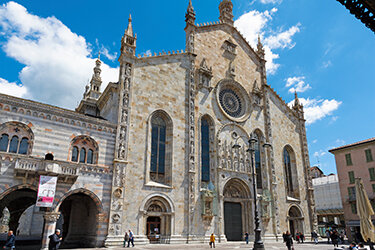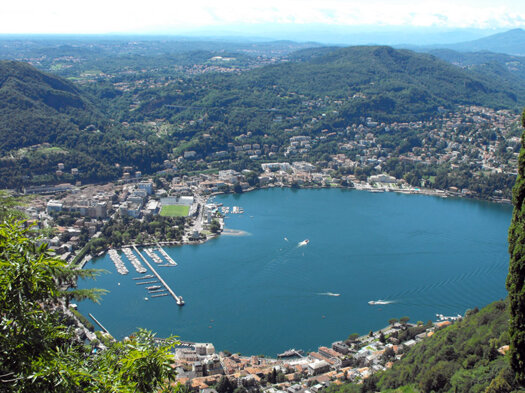Larihome by Casartelli Francesco
Privacy - Cookie policy
Como
Como

The Como Cathedral

Almost four hundred years were employed by the Como craftsmen for the construction of the Cathedral, begun in 1396, whose facade is still today one of the most remarkable examples of late Gothic in northern Italy. Built to replace a previous structure, also dedicated to Santa Maria Assunta, the work for its construction ended in the first half of the eighteenth century with the creation of the Dome designed by Filippo Juvarra. Of notable interest is the facade executed between 1455 and 1486 and enriched with sculptural decorations, largely the work of the workshop of Giovanni Rodari, to whom is attributed the authorship of the two pedestals with the statues of Pliny the Younger and Pliny the Elder.
Almost four hundred years were used by the Como masters to build the Cathedral, started in 1396, whose facade is still one of the most notable examples of late Gothic northern Italy. Built to replace a previous structure, still dedicated to Santa Maria Assunta, the works for its construction ended in the first half of the eighteenth century with the construction of the dome designed by Filippo Juvarra. Of great interest is the frontage executed between 1455 and 1486 and enriched with sculptural decorations.
Info: http://www.visitcomo.eu/it/scoprire/monumenti/chiese/duomo_como/index.html
Palazzo Broletto

Medieval palace, formerly the seat of municipal institutions.
A testimony of medieval times, with later Gothic additions, the Broletto was the seat of municipal institutions starting from the 13th century. A tower with a bell is attached to the palace, used to summon public gatherings. The Broletto is located in the "religious" area of the city, between the Cathedral and the Bishopric. Now used for events and as an exhibition venue, it still retains all the charm of its original era.
Medieval palace, head office of municipal institutions.
A testimony of medieval times, with subsequent Gothic additions, the Broletto is the head office of the municipal institutions starting from the XIII century. A palace tower with a bell was used to recall public meetings. The Broletto is located in the "religious" area of the city, between the Cathedral and the Bishopric. Now used for events and as an exhibition venue, it still retains all the charm of the era of his construction.
Info: http://www.visitcomo.eu/it/scoprire/monumenti/monumenti-fino-900/broletto/index.html
Volta Temple in Como

The building, shaped like a neoclassical temple erected on the lakefront, celebrates the figure and work of the great physicist from Como, Alessandro Volta. The museum was built on the occasion of the first centenary of the death of the inventor of the battery (1927) to house the scientific instruments that belonged to him.
Many of these are original, others are reconstructions of those that were destroyed by the fire of 1899 during the International Electricity Exhibition. The main body of the mausoleum, surmounted by a hemispherical dome, is preceded by a large pronaos with the statues of Faith and Science, which is accessed by two symmetrical flights of stairs. The interior is spread over two floors. In the central hall on the ground floor, the devices, machines, and instruments used by the illustrious scientist for his experiments in physics and electrology, and for the study of gases and their properties, are on display. The loggia on the first floor, on the other hand, displays memorabilia, letters, publications, portraits of the scientist, politician, and professor Alessandro Volta, and the honors bestowed upon him during his life and after his death.
This building is a neoclassical temple built on the lakefront, it celebrates the figure and work of the great physicist from Como Alessandro Volta. The museum was erected for the first centenary of the death of Volta (1927) to host the scientific instruments that belonged to him.
Many of these are original, others are reconstructions of those that were destroyed by a fire in 1899 during the International Electricity Exhibition. The main body of the mausoleum surmounted by a hemispherical dome is preceded by a large pronaos with the statues of the Faith and of Science. The interior is divided into two floors. In the central room of the ground floor you can find the appliances, machines and devices used by the illustrious scientist for physics and electrology experiments, and for the study of gases and their properties. The lodge on the first floor exhibits letters, publications, portraits of the scientist, politician and professor Alessandro Volta, and the honors awarded to him during his life and after his death.
Info:
http://www.visitcomo.eu/it/vivere/luoghi-della-cultura/tempio-voltiano/index.html
Brunate

Brunate is a hamlet of the City of Como, located on a hill behind the lake and reachable by a funicular, from which you can admire a breathtaking view.
The funicular route, in addition to its natural purpose, was used in the early 1900s for many experiments aimed at the study of aerodynamics by Mario Calderara, inventor of the first Italian seaplane, and by engineer Cosimo Canovetti, who would send trolleys with sails of different shapes and sizes down from Brunate to Como to study their behavior and understand the laws of air resistance.
In Como, in fact, we find the "Aero Club Como", the oldest seaplane piloting school in the world, and these experiments testify to the commitment and passion of the people of Como towards the discipline of flight.
The hill is home to splendid Art Nouveau villas, built between the end of the 19th century and the beginning of the 20th century for a wealthy bourgeoisie in search of affirmation.
Also in Brunate we find the Volta Lighthouse, built in 1927 to a design by engineer Gabriele Giussani on the occasion of the celebrations for the centenary of Alessandro Volta's death. The spiral staircase of 143 steps, located inside, allows you to reach the platform at the top at a height of 29 meters. From here there is a 360-degree view of the lake and the villages perched on the surrounding slopes, up to the Alps and Monte Rosa.
You can return to Como on foot by following two paths, one that runs alongside the funicular and one that passes by the Hermitage of San Donato, founded in the 15th century by the Benedictines.
Brunate is a hamlet of the city of Como, located on a hill behind the lake and reachable by funicular, from which you can admire a breathtaking view.
The section of the funicular, as well as for its natural purpose, in the early 1900s was used for many experiments aimed at the study of aerodynamics by Mario Calderara, inventor of the first Italian seaplane, and by the engineer Cosimo Canovetti. They brought down from Brunate to Como special trolleys with sails of different shapes and sizes to study their behavior and understand the aerodunamics laws.
In Como we find the "Aero Club Como", the oldest seaplane piloting school in the world, and these experiments testify to the commitment and passion of the Como people towards the discipline of flying.
The hill is home to splendid Art Nouveau villas, built between the end of the 19th century and the beginning of the 20th century for a wealthy bourgeoisie in search of affirmation.
In Brunate we also find the Volta Lighthouse (“Faro Voltiano”), built in 1927 by the engineer Gabriele Giussani to celebrate the centenary of the Alessandro Volta’s death. The spiral staircase of 143 steps, located inside, allows you to reach the pitch on the top, at 29 meters from the ground. From here you have a 360 degree view on the lake and the villages perched on the surrounding hillsides, and even the Alps and Monte Rosa.
You can return to Como on foot following two paths, the one that runs along the funicular and the one that passes through the Hermitage of San Donato, founded in the fifteenth century by the Benedictines.
Subscribe to our newsletter to stay updated on all the news and receive the best tips on places to visit on Lake Como!
Larihome by Casartelli Francesco
Privacy - Cookie policy